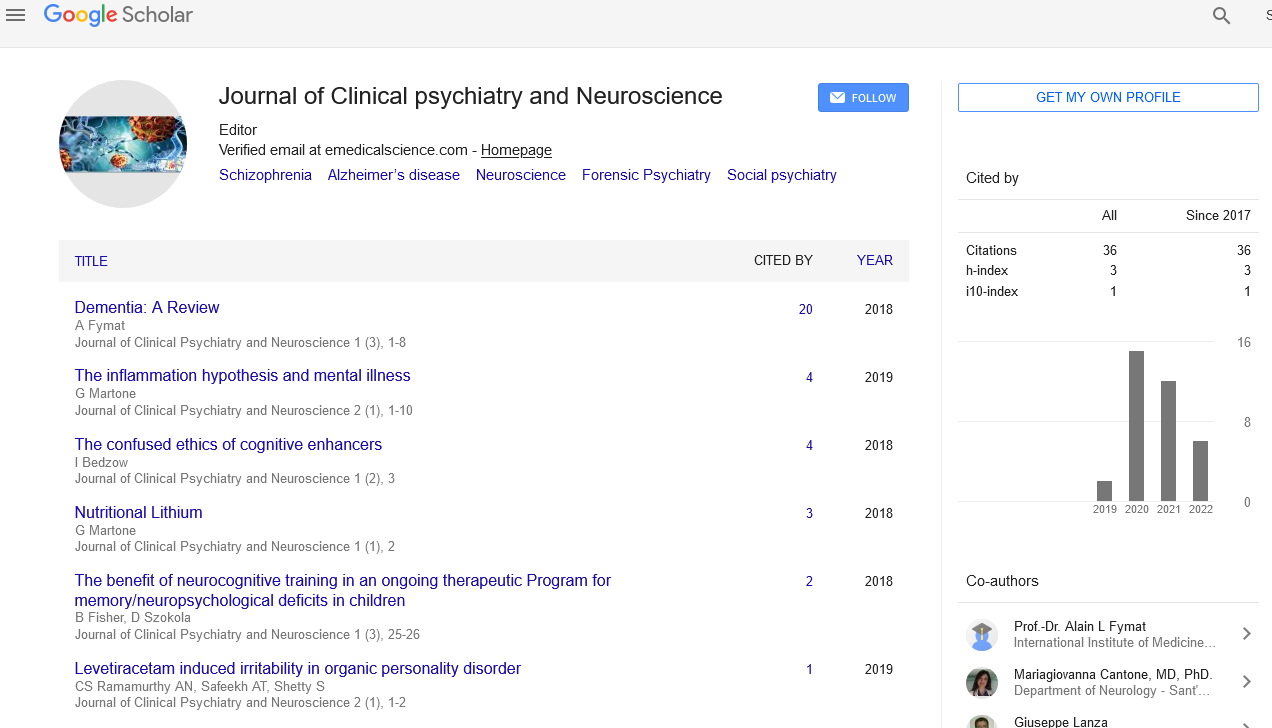Music Therapy in the Modern Era and Its Applications
Received: 04-Nov-2022, Manuscript No. PULJCPN-23-6126; Editor assigned: 06-Nov-2022, Pre QC No. PULJCPN-23-6126 (PQ); Accepted Date: Nov 23, 2022; Reviewed: 19-Nov-2022 QC No. PULJCPN-23-6126 (Q); Revised: 22-Nov-2022, Manuscript No. PULJCPN-23-6126 (R); Published: 26-Nov-2022, DOI: 10.37532/puljcpn.2022.5(6).62-3.
Citation: Haider T. Music therapy in the modern era and its applications. J Clin Psychiatry Neurosci.2022; 5(6):62-3.
This open-access article is distributed under the terms of the Creative Commons Attribution Non-Commercial License (CC BY-NC) (http://creativecommons.org/licenses/by-nc/4.0/), which permits reuse, distribution and reproduction of the article, provided that the original work is properly cited and the reuse is restricted to noncommercial purposes. For commercial reuse, contact reprints@pulsus.com
Abstract
The first study on modern music therapy was published in 1789, and it was titled "music physically considered," and it stated that music can access the emotions and benefit both mental and physical health. As a result, therapists are gradually employing music to aid in healing. As a result, music therapy has had a long road of development.
Key Words
Psychological effects
Introduction
Music therapy genres differ due to differences in culture and thought; in this case, there is no universal scientific definition. However, the American Music Therapy Association (AMTA) has given a brief explanation of music therapy, it is defined as "clinical and evidence based use of music interventions to accomplish individualized goals within a therapeutic relationship by a credentialed professional who has completed an approved music therapy programme.
The Evolution of Music Therapy: Humanity's use of sound and music can be traced back to prehistoric times. During this time period, wizards were accustomed to using sound and music as a healing ritual to achieve exorcism and healing. Following that, the ancient Greeks (800 BCE-146 BCE) were regarded as the forefathers of music therapy, focusing on the psychological effects of music on humans. Music therapy theory was developed by Pythagoras, Plato, and Aristotle, who are considered pioneers. Pythagoras (580-500 BCE) emphasized the importance of using harmonious music to regulate and adjust physical and mental disorders in humans. Aristotle (384 BCE-322 BCE) identified the "Isoprinciple" of music therapy, which states that music expresses a specific emotion that can cause others to express the same emotion.
During the Renaissance (14th-17th centuries), when medicine was rapidly developing, music began to be combined with medicine to treat mental diseases. A large number of scientific studies investigating the application of music in the field of psychology emerged between the 18th and 19th centuries, heralding the birth of modern music therapy. The Second World War provided an opportunity for music therapy to rapidly develop. Many countries, particularly the United States, focused on improving veteran rehabilitation, so many musicians and music teachers joined the med--ical staff. This case prompted the development of numerous professional music therapy courses and related organizations to fill the knowledge gaps of these musicologists and music teachers in medicine and psychology.
The American Music Therapy Association (AMTA), a music therapy organization, was officially established in the United States in 1998. The American Music Therapy Association (AMTA) is a merger of the National Association for Music Therapy (NAMT), founded in 1950 (and which served as the primary professional association for music therapists in the United States), and the American Association of Music Therapy (AAMT), founded in 1971. More than 200 countries have established music therapy associations to date; the world congress of music therapy is held every two years for academic exchanges.
In addition to the well-known modern music therapy, China has its own traditional music therapy development. Around 227 BCE, the emperor's inner canon was the earliest existing medical classic in China; it was the first to introduce five tones into the medical field. Gong, Shang, Jue, Zhi, Yu are the names of the five different tones in the Chinese traditional pentatonic scale, which correspond to the numbers 1, 2, 3, 5, and 6 in modern musical notation. That is, the Gong equals 1 (Do), the Shang equals 2 (Re), the Jue equals 3 (Mi), the Zhi equals 5 (Sol), and the Yu equals 6. (La).
Medical experts continued to develop music's therapeutic effect in practices, as evidenced by historical classics from each dynasty. "Balance and harmonize five tones can nourish every part of the body," according to Bai hu tongli yue (221 BCE). Music, according to Shi jile shu (104 BCE), can be used to move the blood and lift the spirit, thus calming the emotions. These ancient texts demonstrated that people discovered the value of music in humans' qi and blood at the time.
The clinical use of music was documented in poems during the Tang and Song dynasties (618-907 CE, 960-1279 CE).
Music has been used in surgery to reduce patient anxiety and to provide analgesic effect. Aside from that, incorporating music interventions into postoperative rehabilitation can have an analgesic effect, allowing patients to recover faster. Palmer, Lane, and May investigated the impact of music therapy on reducing surgery-related anxiety in breast cancer patients. Before and during the operation, music was played with and without interruption. It was discovered that music can significantly reduce pre-surgery anxiety; patients could feel the song's power of support, and the operation went smoothly. A study with 182 postoperative patients was carried out. These participants were randomly assigned to one of two groups: Music Intervention (M) or music combined with therapeutic suggestions (M/TS).





